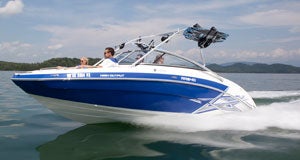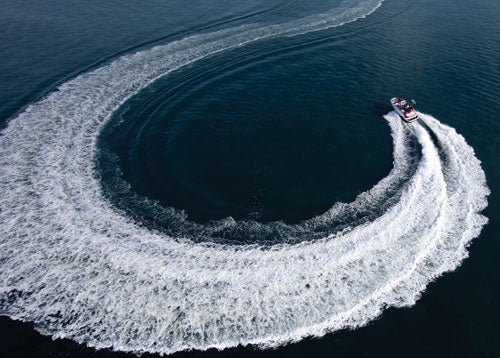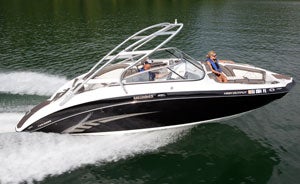Why Buy a Jet Boat?
The pros and cons of jet propulsion
Jet boats — sorry, manufacturers would like us to start calling them “sport” boats — continue to prove strong alternatives to the traditional sterndrive runabout. And with their familiar propulsion (and Yamaha and Sea-Doo dominating the market), it makes sense that a personal watercraft enthusiast may be drawn to them.
But what about all those supposed shortcomings of jets? Let’s take a closer look…you may be surprised at the truth.
Safety First
 With no propeller spinning below the surface, jet-powered boats are safer for swimmers and skiers.
With no propeller spinning below the surface, jet-powered boats are safer for swimmers and skiers.If there’s one trait no one can criticize a jet-powered boat on, it’s the safety factor of not having a propeller in the water. Thanks to the enclosed jet pump system, there’s no swirling propeller exposed to swimmers or skiers, no bulky outdrive that can strike or cause damage. Sure, sterndrive manufacturers have done a great job of protecting those props under extended swim platform, but apples-to-apples, jet drive is the safer alternative.
Shallow Draft
That same safe drive system is also decidedly practical. Unlike a sterndrive that hangs low in the water, a jet’s typical draft is little more than 12”. That means you can navigate shallower waters, and have far less worry about striking an underwater object and doing damage to your prop or drive. Likewise, a jet will lessen the worry of running aground; even if you do, a jet-powered boat will offer less resistance thanks to its sleek bottom and lack of drive hardware, and be easier to get back underway.
Acceleration
 Jet-powered boats get up to speed in a hurry.
Jet-powered boats get up to speed in a hurry.Jet manufacturers love this one. Jet-drive boats typically accelerate harder out of the hole than their sterndrive counterparts, and have far less bowrise that can make the driver lose sight of the water ahead. That makes them both a thrilling ride, and a safe one, keeping the captain aware of his surroundings at all times.
Handling
Hop from a jet drive to a stern drive or outboard, and you’ll instantly notice the handling difference. A jet nozzle can redirect its thrust in an instant, giving the boat a quick and nimble handling experience that, when driven responsibly, is an absolute thrill. That aggressive handling isn’t just all about fun factor; it gives the boat an added level of safety in a collision-avoidance situation, when near instantaneous reactions can make all the difference.
 A jet nozzle allows the driver to redirect thrust instantaneously, which results in impressive high-speed handling characteristics.
A jet nozzle allows the driver to redirect thrust instantaneously, which results in impressive high-speed handling characteristics.Of course, jets do have their tradeoffs, and it’s best to know what they are before making a purchase decision. Some of these traits will rapidly diminish with experience. In fact, I’d argue many are the result of a captain trying to drive a jet like a sterndrive, rather than learn to use its unique handling traits. Still, several points are worth consideration.
No Rudder
With minimal practice, a driver can learn an exceptional level of low-speed control with a jet boat. Sea-Doo showcased this fact at a recent press intro, where all in attendance were invited to do some amazing close-quarters maneuvering. Still, there are times, especially in windy conditions, when a skeg or rudder in the water will be missed. The lack of any hardware below also means a strong skier or wakeboarder will be able to pull the boat far more than they ever could with a sterndrive.
 It’s easier for a skier or wakeboarder to pull a jet-powered boat.
It’s easier for a skier or wakeboarder to pull a jet-powered boat.No True Neutral or Reverse
Jet impellers go in one direction only, and are always in motion when on. Neutral and reverse are achieved by dropping a bucket over the nozzle, and redirecting thrust, either down, to the sides, or forward. That said, the latest designs mimic a true neutral and reverse quite well. And again, with practice, I’ve seen experienced captains maneuver a jet boat like no sterndrive or outboard. The key? Practice, and again, learning to drive the boat to play to its strengths, rather than trying to get by with a propeller boat’s mindset.
Efficiency
 Modern jet-powered engines offer fuel efficiency on par with sterndrive boats.
Modern jet-powered engines offer fuel efficiency on par with sterndrive boats.Do jets burn more fuel? At one time, the answer was yes, although it was minimal. Today’s fuel-efficient engines, however, have pretty much evened the playing field.
In the end, I’d say the “sport boat” manufacturers have accomplished what they set out to do — establish that jet drive is just another legitimate alternative in propulsion.
But you’re a PWC enthusiast, so you already know that.
Related Reading
Fuel-Saving Tips for Personal Watercraft
Superchargers: The Performance Boost of Choice
How to Repair Personal Watercraft Hull Damage
What You Should Know About Ethanol in Your PWC’s Fuel
Five Ways to Beat Saltwater Corrosion
Get PersonalWatercraft.com in your Inbox!
Like PersonalWatercraft.com on Facebook
Comments
Most Popular

2025 Yamaha JetBlaster PRO 2-Up Review

2024 Kawasaki Jet Ski STX 160X Review

Remembering the Sea-Doo XP

Whatever Happened to the Wetbike?

2025 Yamaha JetBlaster Review












 Your Privacy Choices
Your Privacy Choices